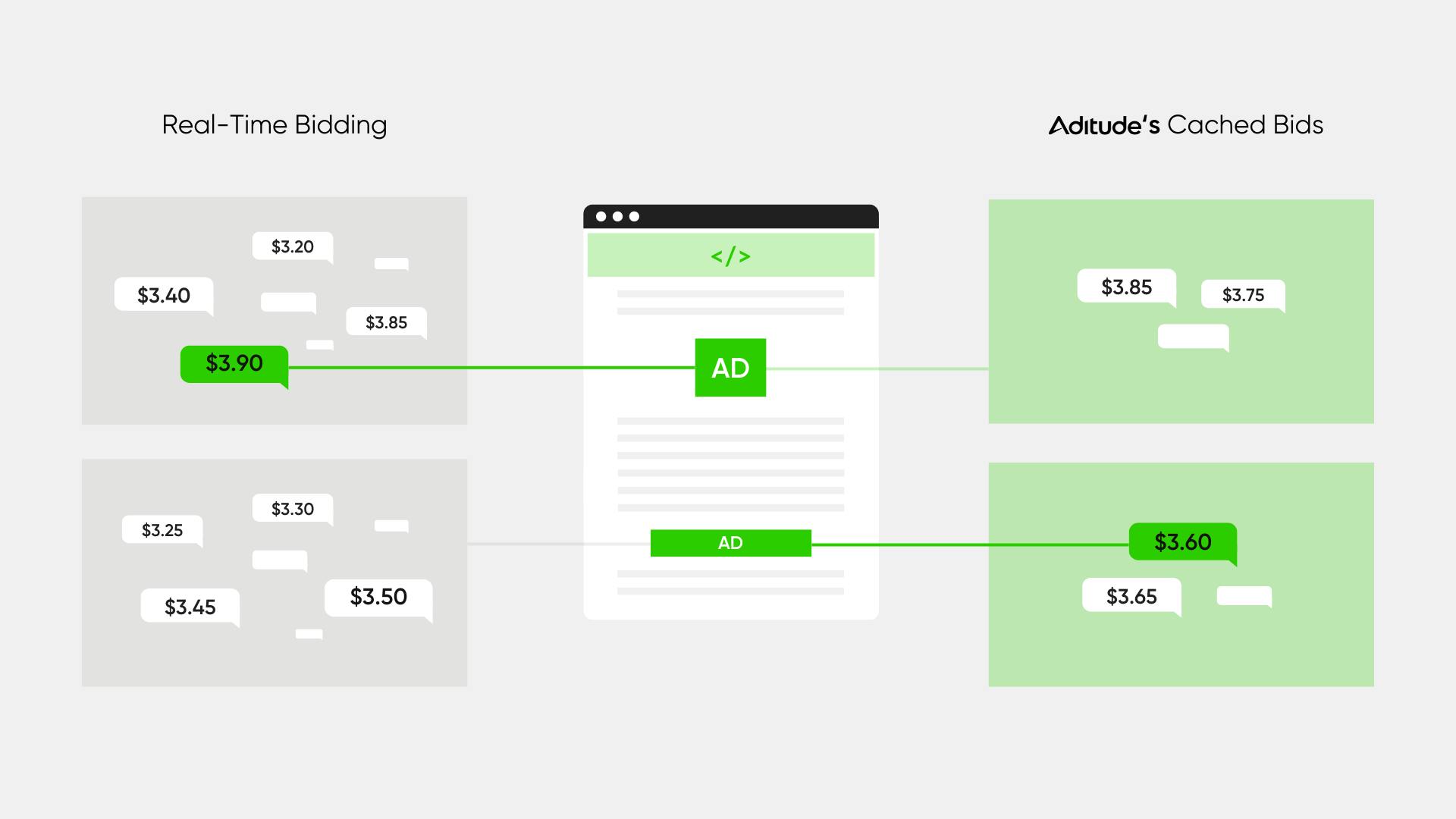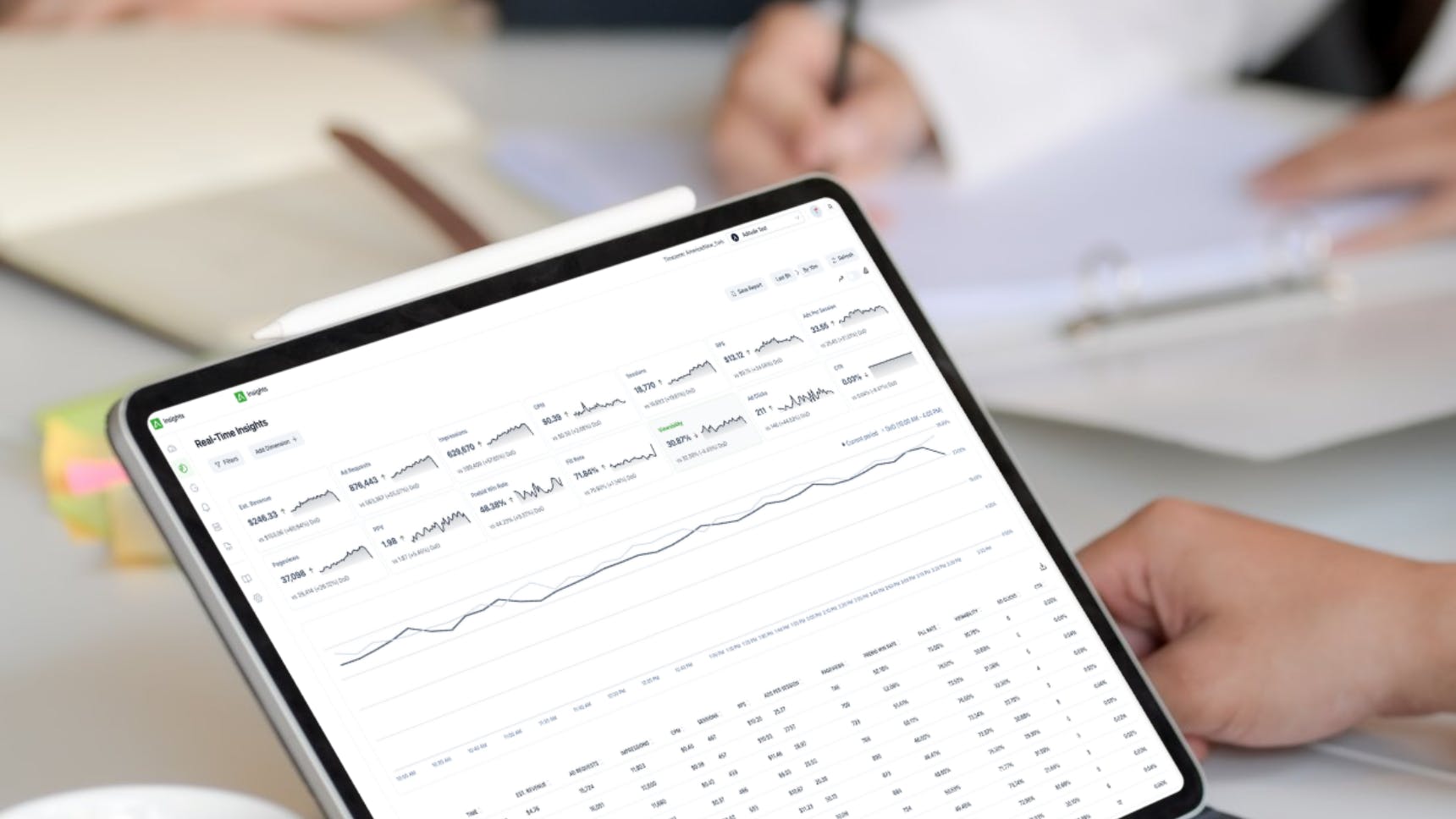Navigating the Complexities of Bid Caching in Programmatic Advertising
Dive into the world of bid caching with our comprehensive guide. Understand this technique's nuances, benefits, and concerns, and explore best practices to optimize your advertising strategy.

In the fast-evolving world of programmatic advertising, bid caching has become a topic of considerable debate among publishers, advertisers, and Ad Tech professionals. Understanding the nuances of bid caching, its benefits, concerns, and best practices is crucial for publishers looking to optimize their strategies.
This blog post aims to demystify bid caching, compare it with bid pooling, discuss its implications for publishers, and explain how Aditude helps. Let’s dive in!
What Is Bid Caching?
Bid caching is a technique used by some ad exchanges. In this technique, a bidder's unsuccessful bid for an ad impression is saved and then used for a different impression later on, often without the bidder's knowledge or consent. This process can happen within a short timeframe, allowing for the reuse of bids on similar content or user profiles, ostensibly to increase fill rates and improve efficiency.

Bid Caching vs. Bid Pooling
While they may sound similar, bid caching and pooling are distinct concepts. Bid pooling involves collecting bids over time and selecting the best one when an ad slot becomes available. Unlike bid caching, bid pooling is typically more transparent and agreed upon by all participating parties, making it a more accepted practice in programmatic advertising.
How Does Bid Caching Work?
Bid caching is an additional step in a typical auction. Here's a step-by-step explanation of how bid caching works:
1 - Ad Request Triggered: The process begins when a user visits a website or app where ad space is available for monetization. When the webpage or app loads, it triggers an ad request to the supply-side platform (SSP) or ad exchange.
2 - Auction Initiated: Upon receiving the ad request, the SSP or ad exchange initiates an auction to determine which ad to serve and from which advertiser. This involves inviting bids from multiple demand-side platforms (DSPs) representing advertisers interested in targeting the user.
3 - Bid Request Submitted: DSPs receive the bid request containing information about the user, the ad opportunity (e.g., ad size, format, context), and other relevant data. Each DSP evaluates the request based on its targeting criteria, campaign settings, and user profile to determine a bid amount.
4 - Bids Submitted for Real-Time Bidding (RTB)Real-Time Bidding (RTB): The DSPs participating in the auction submit their bids in real-time. Bids are typically based on factors like the value of targeting the specific user, campaign budget, bid strategy, and competitive landscape.
5 - Winning Bid Selected: The SSP or ad exchange collects all submitted bids and determines the winning bid based on the highest bid amount. The DSP associated with the winning bid gets the opportunity to serve their ad to the user.
6 - Ad Served: The winning DSP sends the ad creative to the SSP or ad exchange, which then delivers the ad to the user's device. The ad is displayed within the webpage or app where the ad space was requested.
7 - Bid Caching Initiated: After the auction is completed and the winning bid is determined, the SSP or ad exchange may decide to cache (or store) the winning bid information temporarily in the browser. This decision is based on predetermined caching policies, which consider factors like the caching duration and user identification.
8 - Subsequent Ad Requests: If the same user generates another ad request within the caching period (e.g., a few seconds or minutes), the SSP or ad exchange can reuse the cached winning bid instead of initiating a new auction. This means that the same highest bid is used to serve subsequent ads to the same user during the caching period.
9 - Bid Expiry and Refresh: Once the caching period expires, the SSP or ad exchange may no longer use the cached bid for new ad requests from the same user. Instead, a new auction is triggered to determine the winning bid based on the current market conditions.
Benefits for Publishers
Bid caching can offer several benefits for publishers, including:
- Reduced Latency and Improved Ad Serving Speed: By reusing the highest bid for subsequent ad requests from the same user within a short time frame, bid caching can significantly reduce the latency associated with ad serving. This leads to faster ad delivery and a better user experience.
- Increased Fill Rates and Revenue: With bid caching, there's a higher likelihood of filling ad impressions since the highest bid from a previous auction is reused. This can lead to increased ad inventory monetization and higher revenue potential for publishers.
- Enhanced Sustainability: Bid caching significantly enhances sustainability by minimizing computational demands through reducing redundant auction requests for repeated ad inquiries from the same user. This streamlined efficiency not only delivers cost savings to ad tech platforms and publishers but also reduces overall energy consumption and digital waste in the advertising ecosystem.
Concerns for Publishers
While bid caching offers advantages such as improved efficiency and revenue potential, it also introduces fairness, transparency, and ad performance challenges. Ad tech platforms and stakeholders must carefully evaluate bid caching strategies to strike a balance between efficiency gains and maintaining a fair and transparent programmatic advertising ecosystem.
Concerns for bid caching include:
- Fairness and Transparency: Bid caching can raise concerns about fairness in programmatic auctions, as subsequent auctions may not reflect real-time market conditions. This lack of transparency can lead to questions about the integrity of the bidding process.
- User Experience Impact: If bid caching leads to serving less relevant or timely ads to users due to reused bids, it can negatively impact user experience and engagement with ads. This could result in lower click-through rates and ad performance metrics.
- Optimization Challenges: Determining the optimal caching duration and criteria for bid reuse requires careful consideration. Bid caching strategies must balance efficiency with fairness and effectiveness to ensure optimal outcomes for all stakeholders.
- Regulatory and Compliance Considerations: Bid caching practices may need to comply with industry regulations and guidelines related to data privacy, user consent, and fair competition. Adhering to these requirements adds complexity to bid caching implementation.
- Dynamic Market Conditions: Programmatic advertising operates in a dynamic market where bidding behaviors and user interests can change rapidly. Bid caching strategies must be adaptable to these changing market conditions to remain effective.
Bid Caching Best Practices
The ethics and effectiveness of bid caching depend primarily on execution. With full transparency and consent, bid caching can be a tool for efficiency in programmatic advertising. However, these elements can lead to satisfaction and trust.
If you’re a publisher, these are some of the best practices to know when it comes to bid caching:
- Transparency and Disclosure: Advertisers and demand-side platforms (DSPs) should use bid caching transparently. Clear communication with supply-side platforms (SSPs) and publishers is essential to maintain trust and ensure fair competition.
- Time Limit on Bid Caching: Limit the duration for which bids are cached (e.g., a few seconds) to ensure that bids remain relevant and competitive for subsequent ad requests. Avoid excessively long caching periods that could disadvantage advertisers. SSPs set their own rules for bid caching so it’s important to reach out to your ad tech vendor and/or SSP to understand what their rules are.
- Dynamic Pricing Adjustments: Consider implementing dynamic floor pricing adjustments based on changing user behavior or market conditions. This can mitigate the risk of serving ads based on outdated bid information.
- Auction Transparency: Ensure that bid caching practices do not compromise the transparency and integrity of the auction process. All participants should have equal and fair competition opportunities based on real-time bidding data.
- Testing and Monitoring: Continuously monitor the impact of bid caching on ad performance metrics such as win rates, viewability, and user engagement. Regular A/B tests should be conducted to evaluate the effectiveness of bid caching strategies.
- Industry Standards and Guidelines: Adhere to industry standards and guidelines related to bid caching, such as those established by organizations like the Interactive Advertising Bureau (IAB) or the Trustworthy Accountability Group (TAG).
Implementing these best practices can help mitigate potential risks associated with bid caching while optimizing the efficiency and effectiveness of programmatic advertising transactions.
How Does Aditude Help
Aditude addresses the challenges of bid caching head-on. Our Cloud Wrapper utilizes bid caching and provides publishers with:
- Improved Efficiency and User Experience: Aditude helps optimize ad serving by implementing bid caching. By reusing the highest bid from a previous auction for similar ad requests from the same user within a short time frame, Aditude eliminates the need for repeated auctions. This results in faster ad serving and an improved user experience due to reduced latency in delivering ads.
- Resource Utilization Optimization: With bid caching, Aditude minimizes redundant auction processes. By not initiating new auctions for every similar ad request, Aditude optimizes resource utilization within the advertising ecosystem. This efficiency leads to cost savings and better use of computational resources.
- Insight into Inventory Availability and Revenue Forecasting: Aditude likely provides better insights into ad inventory availability and revenue forecasting. By understanding ad demand patterns and bid caching behavior, Aditude can offer more accurate predictions of ad inventory usage and potential revenue, enabling better planning and optimization strategies.
- Increased Revenue Potential: Bid caching implemented by Aditude can significantly boost revenue generation for publishers and ad tech platforms. By minimizing auction redundancies and serving more targeted ads based on cached bids, Aditude helps increase fill rates and potentially boosts ad revenue.
Aditude's bid caching capabilities contribute to a more efficient, streamlined, and optimized programmatic advertising process. By reducing latency, improving user experience, optimizing resource utilization, and providing valuable insights, Aditude enables publishers to maximize the benefits of bid caching while enhancing overall operational efficiency and revenue potential.
Conclusion
Bid caching represents a complex facet of programmatic advertising that requires careful consideration and management. By understanding its mechanisms, benefits, and concerns, publishers can make informed decisions that align with their strategic goals. With solutions like Aditude, the digital advertising ecosystem can harness the power of bid caching in a way that benefits all involved, paving the way for more efficient and effective advertising campaigns. Contact our team to see how we can help you maximize your monetization!



